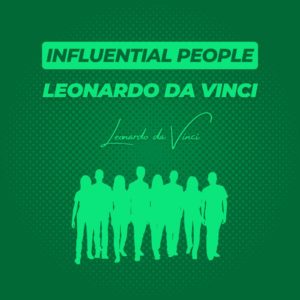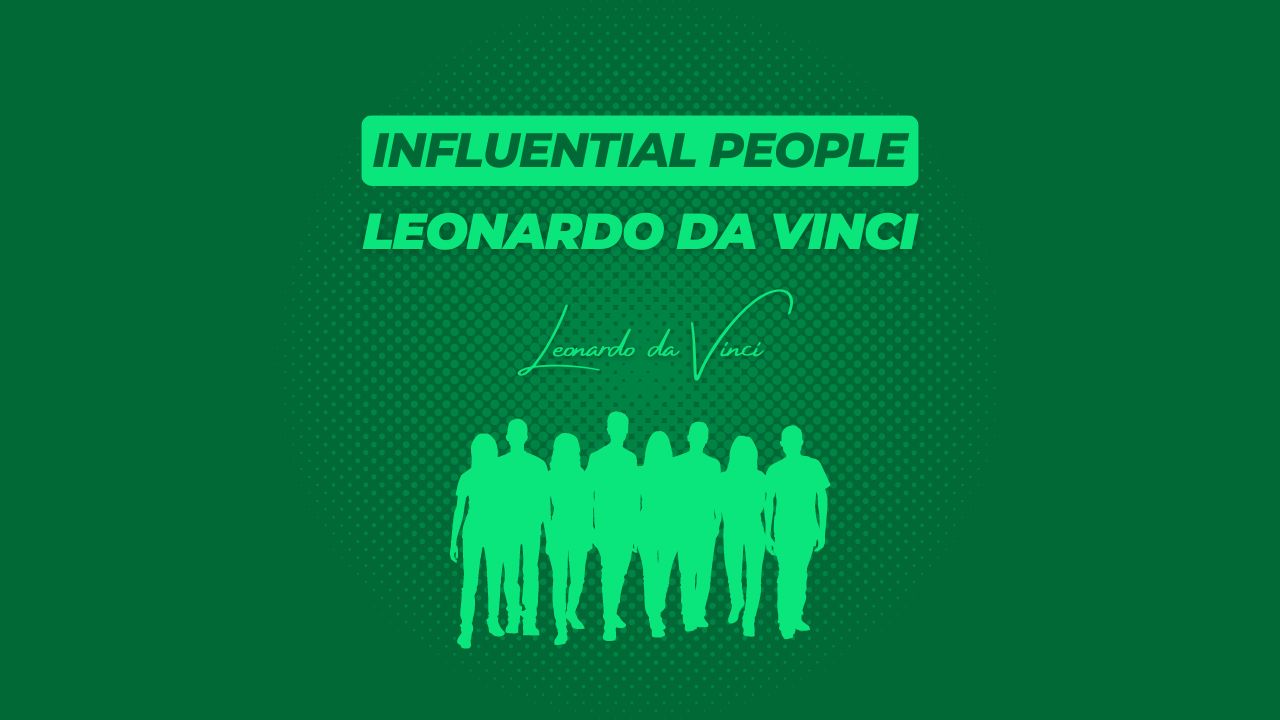Introduction to Leonardo da Vinci
Leonardo da Vinci, a towering figure of the Renaissance, epitomised the ideal of the “Renaissance man,” someone whose unquenchable curiosity was equalled only by his powers of invention. Renowned primarily for his masterpieces such as “The Mona Lisa” and “The Last Supper,” Leonardo’s contributions far surpassed the boundaries of art, delving deep into the realms of science, engineering, anatomy, and geology, among others. His work transcended the ordinary, blending scientific precision with artistic mastery in ways that continue to influence countless fields today. As we explore his life and legacy in this series on ‘Influential People’ for Online Dating UK, Leonardo da Vinci emerges not just as an artist or a scientist, but as a visionary who saw the interconnectedness of all things, making him a beacon for those navigating the complexities of modern relationships and human connections. His lesser-known works, like his intricate anatomical sketches or his conceptual designs for flying machines, reveal a mind always in motion, endlessly exploring the potential of the human experience. This exploration of both the grandeur and the minutiae of life renders him a profoundly relevant figure for our ongoing conversation about influence and inspiration in the context of dating and personal relationships.
“The Last Supper,” Leonardo’s contributions far surpassed the boundaries of art, delving deep into the realms of science, engineering, anatomy, and geology, among others. His work transcended the ordinary, blending scientific precision with artistic mastery in ways that continue to influence countless fields today. As we explore his life and legacy in this series on ‘Influential People’ for Online Dating UK, Leonardo da Vinci emerges not just as an artist or a scientist, but as a visionary who saw the interconnectedness of all things, making him a beacon for those navigating the complexities of modern relationships and human connections. His lesser-known works, like his intricate anatomical sketches or his conceptual designs for flying machines, reveal a mind always in motion, endlessly exploring the potential of the human experience. This exploration of both the grandeur and the minutiae of life renders him a profoundly relevant figure for our ongoing conversation about influence and inspiration in the context of dating and personal relationships.
Early Life and Education
Leonardo da Vinci was born in 1452 in the small Tuscan town of Vinci, Italy, as the illegitimate son of a notary, Piero da Vinci, and a peasant woman, Caterina. This humble beginning in a rural setting did not hint at the genius that was to unfold. Vinci, nestled in the heart of the Italian Renaissance, provided a backdrop rich with the cultural and artistic fervor that was sweeping through Italy at the time, which played a pivotal role in his development.
Leonardo’s formal education was basic and did not extend far beyond reading, writing, and mathematics. However, his artistic talents were evident early on, leading to his apprenticeship at the age of 14 with Andrea del Verrocchio, one of the most successful artists in Florence. This apprenticeship was crucial, as Verrocchio’s workshop was not just a training ground for painting and sculpture but a vibrant intellectual hub where Leonardo was exposed to a broad spectrum of activities including drafting, chemistry, metallurgy, metal working, plaster casting, leather working, mechanics, and carpentry as well as the theoretical studies of art.
Under Verrocchio’s tutelage, Leonardo was exposed to both theoretical training and a wide range of technical skills. He learnt artistic techniques that included perspective, which later played a significant role in his scientific observations and visual representations in both art and science. The interdisciplinary environment of the workshop helped shape his method of integrating science and art in his subsequent works, fostering a mindset that sought to explore and understand the interconnectivity of the world around him. This formative period laid the groundwork for his future explorations and inventions, making his approach to science as innovative as his art was mesmerising.
Leonardo’s Views on Love and Human Relationships
Leonardo da Vinci’s views on love and human relationships, though less documented compared to his artistic and scientific exploits, offer intriguing insights into his complex personality and worldview. His writings and personal correspondences occasionally touch upon themes of love and affection, reflecting a renaissance ideal that valued intellectual love over carnal passions. Leonardo often emphasised the spiritual and intellectual dimensions of love, aligning with the Platonic tradition that celebrated the beauty of the soul and the mind above the physical form.
In his notebooks, Leonardo occasionally mused on the nature of love as a force that binds the universe, reflecting the interconnectedness that he observed in nature and human anatomy. His views were progressive, seeing love as an ennobling power that elevated the human spirit. This perspective was mirrored in his art through the nuanced expressions of his figures, where the complexity of human emotions and relationships was captured with profound empathy and subtlety.
Leonardo’s relationships with his patrons and contemporaries also significantly shaped his career and personal life. His patrons, like Ludovico Sforza, provided him not only financial backing but also a social and political environment that influenced his work’s content and thematic focus. For instance, his relationship with the Sforza court is evident in works like “The Last Supper,” commissioned by Ludovico, where the emotional interactions between the figures reflect deep relational insights.
Moreover, Leonardo’s interactions with other scholars and artists of the time, such as Machiavelli, Michaelangelo, and Raphael, although competitive at times, spurred him to further innovation. His rivalry with Michaelangelo is particularly notable, pushing both artists to new creative heights. These relationships, filled with both camaraderie and rivalry, underscored his belief in the intellectual stimulation that comes from engaging with peers, which for him was as important as romantic or familial bonds.
Thus, Leonardo viewed relationships—whether based on love, friendship, or intellectual kinship—as fundamental to personal and creative growth, influencing both his life and his legacy. This holistic view on relationships can provide modern readers with a reflective lens on how relationships shape personal and professional lives, a concept deeply resonant in the context of contemporary dating and personal development.
Artistic Contributions: A Lens on Human Emotion
Leonardo da Vinci’s approach to art was revolutionary, not just in technique but in how he captured the depth of human emotion and the subtleties of expression. His masterpieces, such as “The Last Supper” and “Mona Lisa,” are exemplary in showcasing his skill at conveying complex psychological states through art.
“The Last Supper,” one of his most famous murals, illustrates Leonardo’s genius in using facial expressions and body language to tell a story and convey a range of emotions in a single scene. The painting depicts the moment Jesus announces that one of his disciples will betray him, capturing the shock, denial, and confusion of the disciples. Each figure is unique, with emotions that range from outrage to grief—all portrayed with subtle details that bring the scene to vivid life.
The “Mona Lisa,” arguably the most renowned portrait in the world, is a testament to Leonardo’s mastery of the human form and his understanding of psychology. The sitter’s enigmatic smile and her direct gaze create an intimacy with the viewer, making her emotions palpable but not fully readable, inviting endless interpretation and fascination. The delicacy of her smile suggests a serene composure that some suggest hints at a hidden knowledge or a secret, showcasing Leonardo’s ability to layer emotion and depth into his work.
Leonardo’s scientific studies, particularly in human anatomy, played a crucial role in enhancing his ability to portray the human figure with realism and accuracy. His anatomical sketches, which include detailed drawings of muscles, tendons, and other bodily structures, reflect his belief that a deep understanding of the human body was essential to accurately depicting it in art. These studies not only improved his artwork technically but also enriched his capacity to express the subtleties of human emotions and physicality.
Leonardo’s dissections of human bodies, which were revolutionary at the time, informed his art with a medical accuracy that had not been seen before. This blend of art and science was pivotal, as it allowed him to achieve a realism that was both scientifically accurate and emotionally resonant. His ability to translate anatomical knowledge into artistic expression made his characters lifelike, bridging the gap between empirical study and artistic creativity.
In examining these elements of Leonardo’s work, we see a profound understanding of the human condition—an understanding that resonates with the complexities of personal interactions and emotions in today’s world. His work encourages a deeper appreciation of the intricate nature of human expressions and emotions, insights that are invaluable in the realm of modern relationships.
Influence on Modern Romance and Aesthetics
Leonardo da Vinci’s deep understanding of human psychology and emotion has a surprising and profound relevance to contemporary notions of romantic attraction and aesthetic appreciation. His work and insights, derived from a blend of artistic innovation and scientific inquiry, resonate deeply with modern ideals of beauty and harmony, influencing how these concepts are perceived and valued in today’s society.
Leonardo’s portrayal of human emotions in his artworks, with an almost divine attention to detail and realism, offers a lens through which we can view our own understanding of personal and romantic connections. His ability to capture the subtleties of human expression speaks to the modern viewer about the complexity of relationships and the unspoken nuances of personal interaction. This is particularly relevant in the realm of online dating, where the visual impression and subtle cues in profiles and photographs can significantly influence romantic outcomes.
In terms of aesthetics, Leonardo’s emphasis on symmetry and proportion in his art and his scientific studies reflects the modern ideal that beauty often lies in balance and harmony. This principle can be directly applied to the visual aesthetics of today’s social media platforms, where symmetry and harmony are often critical to user engagement and aesthetic appeal. The way that Leonardo combined aesthetics with functionality in his designs, such as his plans for ideal cities, can also be seen in how modern design often combines form and function to create spaces that are both pleasing and practical.
Moreover, Leonardo’s appreciation for beauty was not confined to the visual arts; it extended to his conceptual understanding of the universe. His notion that all things in nature are interconnected and that true beauty stems from this harmony can be paralleled with modern holistic approaches to wellness and personal development, which are often integral to contemporary romantic ideals. In the dating world, this translates into the search for a partner who not only appeals visually but also resonates on multiple levels—intellectual, emotional, and spiritual.
His influence extends into how modern audiences value authenticity and depth. Just as Leonardo sought to reveal the layers beneath the surface—both literally in his anatomical sketches and metaphorically in his paintings—modern daters look for depth and authenticity in potential partners. The desire to connect on a deeper level, beyond superficial attraction, reflects Leonardo’s legacy in seeking and portraying profound human truths.
Leonardo da Vinci’s work reminds us that beauty, whether in art or in a person, is complex and multi-dimensional. His teachings encourage a deeper appreciation of aesthetic and romantic ideals, urging us to look beyond the surface and appreciate the deeper connections that make relationships rich and fulfilling in our own era.
Legacy and Lessons for Modern Dating
Leonardo da Vinci’s life and work offer enduring lessons that transcend the boundaries of time and discipline, providing valuable insights for modern daters. His boundless curiosity, commitment to continuous learning, and deep appreciation for beauty in all its forms are qualities that can enrich personal development and foster more meaningful relationships.
Curiosity
Leonardo’s insatiable curiosity drove him to explore a vast array of subjects, from the intricacies of human anatomy to the mysteries of the natural world. This relentless pursuit of knowledge not only enhanced his art but also broadened his understanding of the human condition. Modern daters can take a leaf from his book, using curiosity to fuel their interactions with potential partners. Asking thoughtful questions, showing a genuine interest in the other person’s thoughts and feelings, and being open to new experiences can deepen connections and make dating more fulfilling.
Continuous Learning
Leonardo never saw learning as a finite goal but as an ongoing process. This lifelong commitment to education and improvement is especially relevant in the context of personal relationships, where understanding and adapting to each other’s needs and growth are crucial. By embracing a mindset of continuous learning, individuals can evolve within their relationships, navigating challenges more effectively and embracing changes that foster both personal and shared growth.
Appreciation for Beauty
Leonardo’s appreciation for beauty was not limited to the visual arts; it encompassed a broader philosophical outlook that recognised beauty in complexity and harmony. In the context of modern dating, this translates to appreciating the beauty in people’s quirks, their minds, their stories, and their unique ways of being in the world. Recognising and valuing these elements can lead to more profound and resilient romantic connections.
Holistic Approach
Inspired by da Vinci’s interdisciplinary approach, daters today can benefit from looking at relationships through a holistic lens. This involves understanding how various aspects of life—personal ambitions, mental health, social life, and emotional well-being—interact and affect romantic relationships. By nurturing all aspects of life, individuals can bring a more balanced and healthy self to their relationships, enhancing both their own well-being and the quality of their partnerships.
Leonardo da Vinci’s legacy is a testament to the power of integrating diverse aspects of human experience. By adopting his qualities of curiosity, continuous learning, and an appreciation for the broad spectrum of beauty, modern daters can enhance their approach to finding and cultivating romantic relationships. Encouraging a holistic approach to personal development and relationships not only enriches individual lives but also builds a foundation for deeper, more meaningful connections—mirroring the very essence of what Leonardo celebrated in his exploration of life’s complexities.
Conclusion
Leonardo da Vinci remains a figure of unparalleled genius whose life and work continue to resonate with timeless relevance. His interdisciplinary approach, which seamlessly blended art, science, and philosophy, not only revolutionised the Renaissance but also laid foundational principles that are still pertinent today. Leonardo’s legacy teaches us the value of curiosity, the importance of continuous learning, and the profound appreciation of beauty in its many forms—principles that can profoundly enrich our personal and romantic lives.
Through his masterful art and visionary scientific studies, Leonardo showed us that depth and understanding are crucial to seeing the world in its true form. His dedication to exploring the complexities of human emotion and the physical world offers a blueprint for how we might deepen our relationships and our understanding of one another. In a world often dominated by superficial encounters and fleeting connections, da Vinci’s life encourages us to look deeper, seek harmony, and cultivate a holistic view of love and life.
As we reflect on Leonardo da Vinci’s contributions, one might ask: How can we apply his Renaissance ideals to rekindle our own relationships and personal growth? How can his thirst for knowledge and appreciation for beauty inspire us to foster deeper connections with those around us? Let us draw from da Vinci’s well of wisdom to enrich our modern lives, encouraging a renaissance of our own in how we think, love, and connect.






